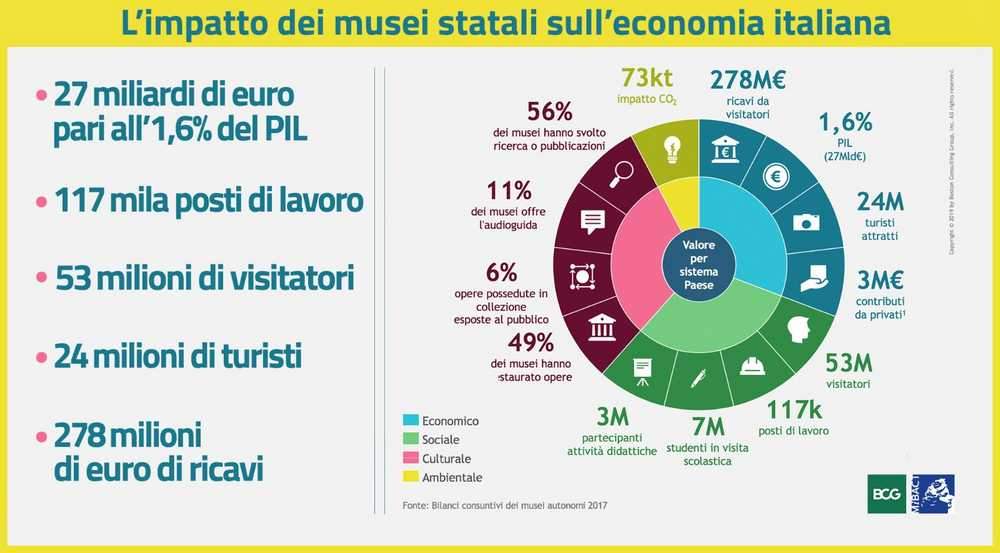State museums generate 117 thousand jobs and 27 billion in GDP. Here is BCG's study
Minister of Cultural Heritage Dario Franceschini presented yesterday in Rome, at the headquarters of the Ministry of Cultural Heritage, the report Culture: strategic lever for the country’s growth, prepared by the Boston Consulting Group (BCG) for the ministry: it is a study on the relevance of state museums for the Italian economy and society. The analysis was conducted in three phases: the first involved the analysis and collection of data to take a snapshot of the reality of museums today, the second was the development of a methodology to estimate the impact of state museums (considering four areas: economic, social, cultural, and environmental), and the third was the estimation of the sector’s potential for the country, in light of an international comparison analysis of 30 museums and our experiences in the museum sector and related sectors.
The analysis covered 358 state-owned museums: the 32 autonomous museums (from the Uffizi to the Colosseum Park, from the Pinacoteca di Brera to the Estensi Galleries and others) and 326 museums belonging to the 17 Regional Museum Poles (all out of a total of about 5 thousand existing museums in Italy, including public, private, ecclesiastical and other museums). The analysis found that the 32 autonomous museums attract 58 percent of visitors and generate 87 percent of state museum revenues: about half of the museums analyzed are spread over five regions (Lazio, with 56, is the region with the most, followed by Tuscany, 55, Campania, 35, Emilia Romagna, 29, and Veneto, 21) while 83 percent of visitors are concentrated in three regions (Lazio, 24.7 million, Campania, 11.6 million, and Tuscany, 7.5 million are the top three regions).
Regarding the four areas of impact, several factors were studied. For the cultural sphere: research (56 percent of museums conducted research or publications), audioguides (offered by 11 percent of museums), percentage of works exhibited to the public (average 6 percent), and restorations (49 percent of museums restored works). For social impact: participants in educational activities (3 million), students visiting schools (7 million), jobs generated (117 thousand direct and indirect), and total visitors (53 million). For economic impact: visitor revenues (278 million euros), impact on Gross Domestic Product (27 billion euros, 1.6 percent of GDP), contributions collected from private individuals (3 million euros). Finally, for the environmental impact, the Co2 impact (73 kt) was calculated. The data refer to 2017.
The research also found that 2 out of 10 tourists come to Italy to visit state-owned im usei: of the 123 million tourists who arrived in Italy in 2017, 42 million came to the country to take a cultural vacation, and of these 24 million came to Italy specifically to visit a state-owned museum.
BCG went on to find that Italian museums have a great deal of untapped potential, especially when compared with foreign museums: private contributions to the total income of Italian state museums barely reach 1 percent (compared with about 20 percent for the international museums surveyed), the percentage of visitors to the potential catchment area is estimated at between 6 and 24 percent (compared with 20 to 50 percent for foreign museums), and revenue per visitor from ticketing and additional services ranges from 2 to 7 euros (compared with 10 to 20 euros abroad). Finally, BCG estimated that museum revenues could increase to 800 million to 1 billion euros (of which 20% from private individuals), the impact on GDP (between direct and indirect effects) could increase to 35-40 billion, 60-80 million visitors could be reached (including 10% students and 5 million participants in educational activities), and, finally, between 150 and 200 thousand direct and indirect jobs could be activated.
Minister Franceschini commented on the data as follows, “Today more than ever it is essential that culture be given a great deal of attention, both because it is a vehicle for nourishing people’s spirits and minds and because it is a great opportunity for economic growth. This study demonstrates that. The government will strengthen investment in culture both because of the constitutional duty to protect cultural heritage and to support cultural heritage businesses operating in our country, but also for all those who work daily in museums, archaeological parks, libraries, archives and peripheral structures of the Ministry.”
According to Giuseppe Falco, managing director of BCG Italy, Greece, Turkey and Israel, the role of culture and art “is fundamental and strategic for the country. It is so from a social, cultural and economic point of view, because of the direct and indirect contribution to development that it can guarantee. This is demonstrated by the numbers, compiled by BCG research on state museums: investing in culture proves to be a key choice for stimulating the growth of our economy. We see a great opportunity to be seized: the positive impacts of such investment can enable a virtuous circle and create additional resources needed to improve accessibility and usability of museums, preserve works and enhance research.”
 |
| State museums generate 117 thousand jobs and 27 billion in GDP. Here is BCG's study |
Warning: the translation into English of the original Italian article was created using automatic tools. We undertake to review all articles, but we do not guarantee the total absence of inaccuracies in the translation due to the program. You can find the original by clicking on the ITA button. If you find any mistake,please contact us.





























